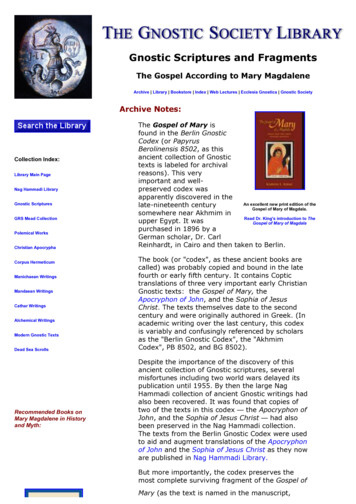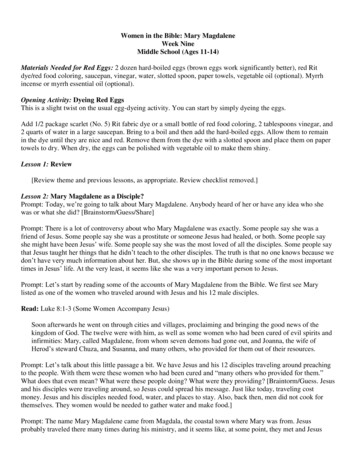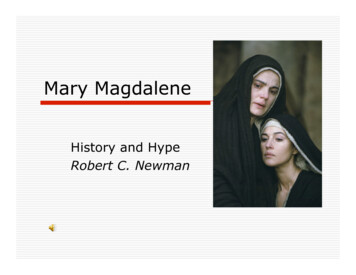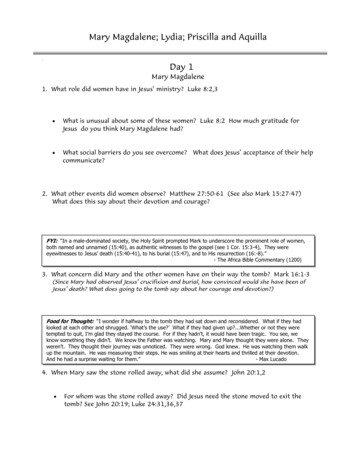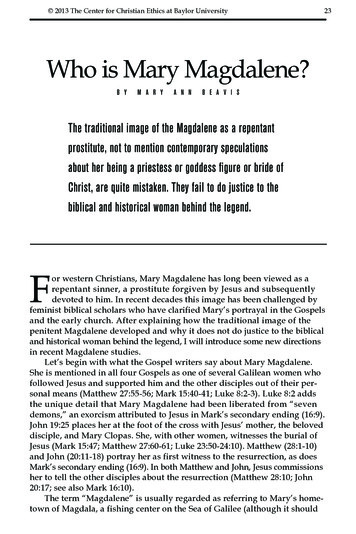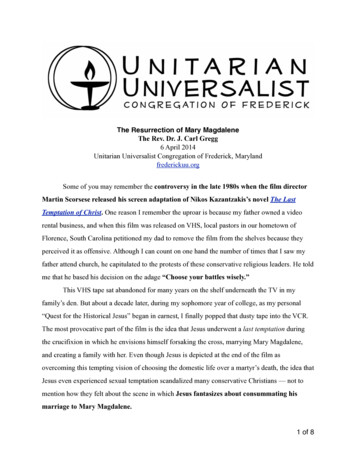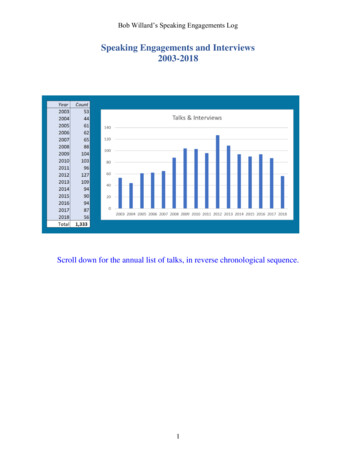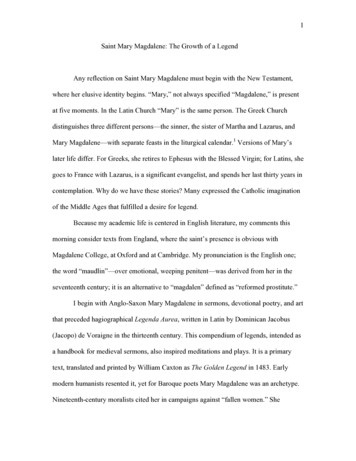
Transcription
1Saint Mary Magdalene: The Growth of a LegendAny reflection on Saint Mary Magdalene must begin with the New Testament,where her elusive identity begins. “Mary,” not always specified “Magdalene,” is presentat five moments. In the Latin Church “Mary” is the same person. The Greek Churchdistinguishes three different persons—the sinner, the sister of Martha and Lazarus, andMary Magdalene—with separate feasts in the liturgical calendar.1 Versions of Mary’slater life differ. For Greeks, she retires to Ephesus with the Blessed Virgin; for Latins, shegoes to France with Lazarus, is a significant evangelist, and spends her last thirty years incontemplation. Why do we have these stories? Many expressed the Catholic imaginationof the Middle Ages that fulfilled a desire for legend.Because my academic life is centered in English literature, my comments thismorning consider texts from England, where the saint’s presence is obvious withMagdalene College, at Oxford and at Cambridge. My pronunciation is the English one;the word “maudlin”—over emotional, weeping penitent—was derived from her in theseventeenth century; it is an alternative to “magdalen” defined as “reformed prostitute.”I begin with Anglo-Saxon Mary Magdalene in sermons, devotional poetry, and artthat preceded hagiographical Legenda Aurea, written in Latin by Dominican Jacobus(Jacopo) de Voraigne in the thirteenth century. This compendium of legends, intended asa handbook for medieval sermons, also inspired meditations and plays. It is a primarytext, translated and printed by William Caxton as The Golden Legend in 1483. Earlymodern humanists resented it, yet for Baroque poets Mary Magdalene was an archetype.Nineteenth-century moralists cited her in campaigns against “fallen women.” She
2inspired Pre-Raphaelite Dante Gabriel Rossetti to paint her as a “stunner,” while his sisterChristina’s poem was a feminist plea. The twentieth century saw a surge of interest,especially The Gospel of Mary that provoked scholarly interest, feminist criticism,novels, musicals, and films.Mary Magdalene in the New Testament and Church PronouncementsBefore turning to legends and literary depictions it is essential to review seminaltexts: the New Testament, which named Mary Magdalene on five occasions, andhierarchical responses. Only Luke specifies her as an early follower of Jesus; he alsoidentifies her as the woman “from whom seven devils had gone out” [8:1-3]. Matthew,Mark, and John place her at the Crucifixion; Luke only implies her presence. All fourGospels report her at the burial and recount her return to the empty tomb. Only Mark andJohn describe Jesus’ first appearance to her after the Crucifixion.Mark briefly tells Jesus’ appearance and Mary’s report to the disciples, “as theywere mourning and weeping. And they, hearing that he was alive and had been seen byher, did not believe it” (16: 11). John introduces the ‘gardener.’ Although Maryannounces her encounter to the disciples, John does not indicate their response. Insteadhe quickly records “that same day, the first of the week, though the doors where thedisciples gathered had been closed for fear of the Jews, Jesus came and stood in the midstand said to them, “Peace be to you!” showed them his hands and his side, the disciplestherefore rejoiced at the sight of the Lord breathed upon them, and said ‘Receive theHoly Spirit; whose sins you shall forgive, they are forgiven them; and whose sins youshall retain, they are retained’” (John 20: 19-20). John concludes with doubting Thomas
3and establishing the primacy of Peter—authority for the Church. The Gospel for 22 Julyis John 20: 1-2 and 11-18 —reminder of Mary’s sins and forgiveness.Other women called “Mary” are identified as Mary Magdalene: Mary of Bethany,sister of Martha who asked Jesus to raise their brother Lazarus from the dead (John 11: 145; 12: 1-8). Mary’s leaving domestic preparations to Martha to sit at Jesus’ feet ispraised: “Mary has chosen the better part which shall not be taken from her” (Luke 10:38-4, John 12: 2-3). Commentators identify ‘the better part’ as the contemplative life.Nevertheless, most influential is the unnamed sinner who washes Jesus’ feet at Simon thePharisee’s banquet (Luke 7: 36-50).Two significant texts, Pope Gregory the Great’s Latin Homilies 33 and 25,defined Mary Magdalene’s character. Both were preached in 591. Homily 33 identifiedthe unnamed sinner: “We believe that this woman whom Luke calls a female sinner,whom John calls Mary, is the same Mary from whom Mark says seven demons were castout.”2 Gregory, having defined the seven demons as the seven cardinal sins (one of whichis lust), explained the ointment used by the unnamed sinner when she anointed Jesus’ feethad previously been used “to perfume the flesh in forbidden acts.” In the words of onecommentator, “holy pornography.” Gregory urged Mary Magdalene’s role as penitent:“She turned the mass of her crimes to virtues, in order to serve God entirely in penance.”3Homily 25, which presented Mary Magdalene as model for the contemplative life,stressed the necessity for perseverance.4 It is the Second Reading for 22 July in TheLiturgy of the Hours. Gregory calls for reflectionon Mary’s attitude and the great love she felt for Christ; for though the disciples had leftthe tomb, she remained. the only one to see him. For perseverance is essential to anygood deed, as the voice of truth tells us: Whosoever perseveres to the end will be saved. 5
4The ardent woman disciple persists when fearful men give up. (In charity, weacknowledge men were more at risk of being martyred.) The Latin Church promulgatedGregory’s characterization for centuries, until the liturgical calendar reform of 1969.In the interim there were changes. Vatican II gradually shifted definition of Maryfrom prostitute / repentant sinner to disciple. Finally, at Pope Francis’s wish,the Congregation for Divine Worship and the Discipline of the Sacramentspublished a new decree, 3 June 2016, Solemnity of the Sacred Heart of Jesus, by whichthe celebration of St. Mary Magdalene, currently obligatory memory, will be elevated inthe general calendar to the level of a feast day. The decree will enable MaryMagdalene to be ‘celebrated’ liturgically like the rest of the apostles.6This was in “the context of the Jubilee of Mercy to stress the importance of this woman,who shows great love for Christ and was very dear to Christ.” Archbishop Arthur Roche(secretary of the Congregation for Divine Worship and the Discipline of the Sacraments)summarized clerical judgments and reforms. Contrasting the gardens of Paradise and ofthe Resurrection has “ecclesiastical importance a good lesson for every disciple ofJesus: do not seek human securities and worldly honours, but faith in the Living andRisen Christ.” Mary Magdalene, eyewitness and “evangelist” because she announced thegood news to the disciples, named by Thomas Aquinas “apostle to the apostles,” deserves“the same level of festivity given to the apostles in the General Roman Calendar.” And “the special mission of this woman [should] be highlighted, as an example and modelto every woman in the Church.” Sadly gender constraints linger—might not men perceivea worthy model? Is not the Church exhorting all to Evangelization a remedy to clericalfailure and scandal?
5Anglo-Saxon Mary MagdaleneMary Magdalene was honored in Anglo-Saxon England. Bede’s Martyrology(c.720) set July 22 as her feast day. Old English Martyrology (9th century) told her life ashermit. Æthelwold of Winchester’s Benedictional (late 10th century), in contradiction toGregory the Great, associated Mary Magdalene with the Virgin Mary, giving her virginalattributes stressed by early cults that praised feminine holiness. In Scotland (then part ofAnglo-Saxon Northumbria) stands the Ruthwell Cross, a rare monument from c.700.Eighteen feet tall, richly carved stone shows the life of Christ, Evangelists, hermits,interlacing, and inscriptions. One broad side’s central image is Mary Magdalene washingChrist’s feet; above she meets Martha (symbolizing active and contemplative life).Eighteen long and comprehensive Blickling Homilies (late 10th century) werebased on the liturgical cycle. “Palm Sunday” introduced Mary Magdalene, Martha, andLazarus at Bethany, where the Saviour responds to Martha’s request that her sister helpdomestically: “Mary hath chosen the best part.” He also rebukes Judas’s objection towasteful expense; Mary “has wrought a good work and this gospel shall be said andpreached throughout all the world, because this was done in remembrance of me.” TheAnglo-Saxon preacher added wryly: “The Jewish folk knew that Jesus was come to thehome of Lazarus, then they proceeded thither, nevertheless, not for his (Jesus’) sake, butout of a desire of curiosity on account of the miracle, and they wished to see Lazarus,whom he had previously raised from the dead.”7 Then the homilist explained:The evangelist has said that Martha and Mary betoken this transitory and fleeting life.Martha received Christ in her house, that she might minister unto him. What does shesignify, but the holy church, that is, believing men who prepare a clean habitation in theirhearts for Christ himself? Mary betokeneth holy church in the future world, whichshall be freed from all its labours, and shall have sight alone of the heavnly glory, andshall rest in the presence of our Lord, and shall unceasingly praise him. [37-38].
6This is a far cry from the repentant prostitute.BL Cotton MS Vespasian D. XIV, early twelfth century, contained forty-nineEarly English homilies. Five were about the Virgin Mary (three Assumption, oneAnnunciation and one Festival of); three featured Mary and Martha. This marked howthese women were associated.8 “XVII” made the same argument as the BlicklingHomilies. Mary and Martha betoken transitory and eternal life, contrasted as a time tohelp the poor and a time when there will be no such necessity. We should imitate Marthafor the former and Mary for the latter. Moreover, the wisdom of Augustine, Jerome, andGregory inspired this English rendering. “XLIII,” beginning with Luke’s account of theSaviour’s visit to Martha’s “cæstele,” recounted Jesus’ praise of Mary’s better choice.The castle / stronghold betokens the pure Virgin Mary. Martha and Mary, complementarycharacters, signify a life of toil and of eternal life, work and contemplation.Saint Anselm (c.1033-1109), Archbishop of Canterbury, sometimes called “fatherof scholasticism,” also “created a new kind of poetry—the poetry of intimate, personaldevotion—written in the rhymed prose of the day.”9 His “Prayer to St Mary Magdalene”asks that “the most evil and sinful of men,” receive mercy as did she. Reflecting on themeeting after the Resurrection, Anselm queries why all-knowing Christ asks, “Woman,why are you weeping? Who are you looking for?” Given her suffering and grief, whydid not Our Lord immediately identify Himself; did Jesus’ compassion end with Hisdeath? “But how should I, in misery and without love, / dare to describe the love of God /and the blessed friend of God?” (206). “One who has sinned against Jesus” and been“indolent” prays to our all-knowing Redeemer: “Hear me, for your love, / and for thedear merits of your beloved Mary, / and your blessed Mother, the greater Mary” (206).
7The Golden LegendAn Italian Dominican priest, Jacobus (Jacopo) de Voraigne (c. 1228/30—1298),wrote the essential text for Mary Magdalene’s legend. Among his many writings were acommentary on St. Augustine, a collection of sermons, and a chronicle of Genoa, wherehe served as Archbishop. Nevertheless, his fame rests on Legenda Sanctorum, the Legendof the Saints. In the Middle Ages “legend” did not mean myth or fable, but “lesson” or“reading.” Emile Male, great French medievalist, named “Readings in the Lives of theSaints” as one of ten books that provide an adequate idea of medieval thought andknowledge. More than 1,000 transcripts document its dissemination; it became known asLegenda Aurea, The Golden Legend—it was worth its weight in gold! Hooray forimaginative storytelling!The first European printing was at Basle c.1440; by 1500 there were at leastseventy-four Latin editions, five French, eight Italian, fourteen Low German, threeBohemian, and three English. Most influential in English was William Caxton’s TheGolden Legend (1483), often reprinted—until faulted by Renaissance humanists andReformation objectors. Vernacular versions attest “popular” literature, not limited to the“learned”—chiefly clergy. Predictably Early Modern humanists protested. Juan Vives(1493-1540), Spanish educational theorist and philosopher who challengedScholasticism, urged study of outstanding Greek and Latin authors as arbiters of truth. Hewas a friend of Erasmus (1466-1536), Dutch humanist and theologian, and of ThomasMore (1478-1535), Catholic martyr and saint. Vives, briefly at the court of Henry VIII(1523-1528), instructed Mary Tudor, daughter of Queen Catherine of Aragon. TheEducation of a Christian Woman (1524) urged study of classical literature and the
8Church Fathers—but also “manual tasks.”10 The ideal princess combines Mary andMartha? Vives objected to the author of The Golden Legend, echoing Erasmus ‘fools’:“those who love to hear or tell feign’d Miracles and strange lyes, and are never weary ofany Tale, though never so long, so it be of Ghosts, Spirits, Goblings, Devils, or the like;which the farther they are from the truth, the more readily they are believ’d and the morethey tickle their itching ears.”11 Here I make a public disclaimer: humanists condemnedmedieval romances, subject of most of my research and books.12The current Catholic Encyclopedia poses alternatives:If we are to judge the “Golden Legend” from an historical standpoint, we mustcondemn it as entirely uncritical and hence of no value, except in so far as it teaches usthat the people of those times were an extremely naive and thoroughly religious people,permeated with an unshakeable belief in God’s omnipotence and His fatherly care forthose who lead a saintly life.If, on the other hand, we view the “Golden Legend” as an artistically composedbook of devotion, we must admit that it is a complete success. It is admirably adapted toenhance our love and respect towards God, to foster our devotion towards His saints, andto animate us with a holy zeal to follow their example. The chief object was towrite books of devotion that were adapted to the simple manners of the commonpeople.13This challenges those committed to evangelization.Introduction to The Golden Legend—I cite Caxton’s translation—identifiedqualities for Mary Magdalene: “lighter” / light-giver, or “lighted”/ enlightened woman:the best parts that she chose: penance, contemplation. heavenly glory. For tofore her conversion she was abiding guilty by obligation of everlasting pain. In theconversion she was garnished by armour of penance. after her conversion she waspraised by overabundance of grace. For whereas sin abounded, grace overabounded, andwas more, etc.”14Characterization was of the repentant sinner, but not belabored.“The Life of S. Mary Magdalene” began with “noble lineage”: parents Cyrus andEucharis, brother Lazarus, and sister Martha—and inheritances.
9Mary had the castle of Magdala, whereof she had her name Magdalene. AndLazarus the city of Jerusalem, and Martha Bethany. And when gave Mary herselfto all delights of the body, and Lazarus entended all to knighthood, Martha administered to knights, and her servants, and to poor men, such necessities as theyneeded. Nevertheless, after the ascension of our Lord, they sold all these things, andbrought the value thereof, and laid it at the feet of the apostles [74].Couched in medieval terms of castle, knights, and charity, this explained who financedapostles. Medieval imagination—wish fulfillment?—enriched.Mary “shone in beauty greatly, and in riches, so much the more she submitted herbody to delight, and therefore lost her right name, and was called customably a sinner.”But she listens to Jesus preach, is inspired by the Holy Ghost, goes to Simon’s house,washes the Lord’s feet with her tears and anoints them with “precious ointments” (74).The Lord “reproved” the Pharisee for his “presumption” in objecting andforgave the woman all her sins. And this is she, that same Mary Magdalene to whom ourLord gave so many great gifts. And showed so great signs of love, that he took from herseven devils. He embraced her all in his love, and made her right familiar with him. Hewould that she would be his hostess, and his procuress on his journey, and he ofttimesexcused her sweetly; against the Pharisee which said that she was not clean, and untoher sister that said she was idle, unto Judas, who said that she was a wastresse of goods.And when he saw her weep he could not withhold his tears. And for love of her he raisedLazarus which had been four days dead; and healed her sister from the flux of bloodwhich had held her seven years. And by the merits of her he made Martelle, chamberer ofher sister Martha, to say that sweet word: Blessed be the womb that bare thee, and thepaps that gave thee suck. But, after S. Ambrose, it was Martha that said so, and this washer chamberer [75].A summary of Gospel references followed this remarkable assimilation of disparatedetails. To Mary Magdalene Christ “appeared first after his resurrection, and was fellowto the apostles, and made of our Lord apostolesse of the apostles” (italics mine 75). In myedition these events fill four pages; the next fourteen pages relate what happened “afterhis ascension.”
10The confluence of scriptural moments was creative; legends are imaginative,albeit given context by geography and monuments. Legends answer the question ‘Whathappened to Mary Magdalene?’ and indeed to other women? Acts detail activities ofmale apostles and followers; The Golden Legend tells Mary Magdalene’s later life.Fourteen years after the AscensionS. Maximin, Mary Magdalene, and Lazarus her brother, Martha her sister,Marcelle, chamberer to Martha, and many other christian men put into a ship in thesea without any tackle or rudder, for to be drowned. But by the purveyance of AlmightyGod they all came to Marseilles [76].The apostles went east, they went west. Seeing the pagan people come to their temple tosacrifice to idols,blessed Mary Magdalen arose up peaceably with a glad visage, a discreet tongue andwell speaking, and began to preach the faith and law of Jesu Christ Then were theyamarvelled of the beauty, of the reason, and of the fair speaking of her. And it was nomarvel that the mouth that had kissed the feet of our Lord so debonairly and so goodly,should be inspired with the word of God more than the other [76].This episode dramatized Mary Magdalene’s role as skillful preacher; moreover, itrecalled her unique closeness to Jesus.Jacobus continued with his richest example of her as evangelist. When the princeof the province and his wife sacrificed to their idols to have a child, “Mary Magdalenepreached to them Jesu Christ and forbade them those sacrifices” (italics mine). In twovisions to the wife, she warns about her husband’s neglect of the poor. The third visioncomes to husband and wife. Mary, “with a frowning and angry visage,” excoriates—“tyrant father the devil serpent thy wife enemy of the cross”—guilty of gluttonywhile “the holy saints of our Lord” perish with hunger, clothed in silk while others lack.Not surprisingly the couple “sigh and tremble”; it is “more profitable for us to obey her,than to run into the ire of her God, whom she preacheth” (italics mine). She prays, and
11the wife conceives. Still skeptical, the husband / prince “would go to S. Peter for to wit itwere true that Mary Magdalene had preached of Jesu Christ” (italics mine). After Marymakes the sign of the cross on their shoulders, the “pilgrims” sail in a well-provisionedship. In the midst of a violent storm, the wife gives birth to a son and dies. Frightenedmariners insist her body be cast into the sea, lest the storm never stop. The grievinghusband asks time to be certain his wife is not “aswoon of the pain” of childbirth. Themariners agree to bury her on a nearby mountain, but the rock is so hard they simplycover the body with a mantle. With no one to nurture the newborn, the prince places thechild on his mother’s breast. He questions “Why?” but continues to S. Peter, who urgesconsolation in the might of God, who gives and takes life. Peter then provides a tour ofJerusalem’s sacred places and teaches the faith. People in the Middle Ages—as today—inthe words of Chaucer “longed to go on pilgrimages.”After two years the prince sails for Marseilles and passes the mountain. He goesashore—and discovers a toddler, “whom Mary Magdalene had kept.” The prince declaresbelief in Mary Magdalene’s efficacy; she kept his son alive; he prays she will restore hiswife. The wife “respired, and took life, and said, like as she had been waked of her sleep:O blessed Mary Magdalene thou art of great merit and glorious” (81). Mary Magdalenetook her on the pilgrimage with S. Peter. The family sail home to Marseilles, where “theyfound the blessed Mary Magdalene preaching with her disciples” (italics mine). Theydestroy “temples of idols” and preach as far as Aix, where Maximin becomes bishop.At this point Mary Magdalene, “desirous of sovereign contemplation,” enters thefinal stage of her life (82)—five pages in Caxton’s translation. In a place “ordained by theangel of God,” she spends thirty years with no bodily comforts. At every “canonical
12hour” she hears “the glorious song of the heavenly companies with her bodily ears” andis fed before being returned, “with no need of corporal nourishing,” to her “proper place.”A hermit priest, seeing this vision, approaches the cave that he soon realizes is “a secretcelestial place” (83). After he prays three times to Jesus for understanding, MaryMagdalene explains “the celestial company” heard and fed her. Because the Lord hasshowed the hour of her death, she asks the priest to tell S. Maximin to go at matins to hisoratory. There hesaw the blessed Mary Magdalene standing in the quire or choir yet among angels thatbrought her, and was lift up from the earth the space of two or three cubits [3 or 4 feet].And praying to our Lord she held up her hands, and when S. Maximin saw her, he wasafraid [after she reassures him, he approaches] and, as it is read in the books of thesaid S. Maximin, for the customable vision that she had of angels every day, the cheerand visage of her shone as clear as it had been the rays of the sun [S. Maximinsummons all the clerks and priests; Mary Magdalene receives the Eucharist] with greatabundance of tears, and after stretched her body tofore the altar, and her right blessedsoul departed from the body and went to our Lord [85].For seven days “sweet-smelling odour”— sign of sanctity—comes from her body. S.Maximin anoints the body, buries it “honourably,” and instructs he is to be buried besideher. Jacobus cited authority; “Hegesippus, with other books of Josephus accord enoughwith the said story” (85).15After detailing removal of relics and miracles, Jacobus mused: “Some say that S.Mary Magdalene was wedded to S. John the Evangelist when Christ called him from thewedding.” HIs loss led her to a life of sin. To prevent “the calling of S. John” being“occasion of her damnation, our Lord converted her mercifully to penance,” replacing“sovereign delight in the flesh with sovereign delight spiritual the love of God. Andit is said that he ennobled S. John tofore all other with the sweetness of his familiarity,because he had taken him from the delight aforesaid” (87-88).
13The medieval imagination was not shy about sexuality. Witness all those paintings of St.Joseph as gray-haired. Jacobus offered an alternative: “Certain authors relate But thisis held to be a false and frivolous tale: and Friar Albert, in his preface to the Gospel ofSaint John, declares the espoused wife whom the apostle left behind to follow Jesusremained a virgin all her life, and later lived in the company of the Blessed Virgin.”16Mary Magdalene also had a part in “The Life of Saint Martha,” assigned to July29. Life in Gaul was filled with wonders! Martha confronts “a great dragon, half beastand half fish, greater than an ox, longer than a horse, having teeth sharp as a sword, andhorned on either side, head like a lion, tail like a serpent, and defended himself with twowings on either side.” Martha “cast on him holy water, and showed him the cross, andstanding still as a sheep, she bound him with her own girdle, and then was slain withspears and glaives of the people” (136). Medieval heroic action is exciting—as arecurrent imitations.Like Mary Magdalene, Martha knows the time of her death. She summons “all theconvent of brethren and of sisters” and bids them rejoice: “for I see the fellowship ofangels bear the soul of my sister Mary unto heaven. O most sweet and fair sister, thoulivest now with thy master and my guest in the blessed seat in heaven.” At night after awind extinguished candles, Martha “saw her sister coming to her, holding a brand in herhand, and lighted the tapers and lamps, and as each of them called other by name, Christcame to them saying: Come, my well-beloved hostess, for where I am thou shalt be withme” (139). “The Life of St. Martha” also noted. “Martilla, her servant, wrote her life,which after went to Sclavonia, and there preached the gospel of Christ, and after tenyears from the death of Martha, she rested in our Lord” (italics mine 140).
14The Golden Legend, like the Gospels, recorded miracles. Caxton’s stress onfeminine beauty and pious devotion combined with intellectual toughness and preachingeloquence enthralled countless English readers—but disconcerted some because heintroduced new material and omitted that deemed unsuitable, including Jacobus’soccasional expressions of doubt. The Golden Legend was “based more firmly onnarrative and moral than that of any of his predecessors; it is simpler and lessquestioning.”17 Woodcuts greatly enhanced the book’s appeal.18“God’s Plenty”Preaching, which often employed legends, occasioned intense responses infourteenth-century England. A Poetry Appendix in The Liturgy of the Hours quotesGeoffrey Chaucer (c.1340-1400) and William Langland (1330-1400). Chaucer’s portraitof the Parish Priest is the ideal, “rich of holy thought and work a learned man /That Christes gospel truly would preach.”19 His Parson’s Tale, a sermon on the SevenDeadly Sins, had two references to Mary Magdalene. One example of Envy is Simon thePharisee who bore a grudge against her when she ‘wept at Jesus’ feet for her sins’ (X.502-504). A long section on woman’s chastity illustrated Lechery. Widows who lead aclean life are praised as ‘the vessels / containers of the blessed Magdalene, that fulfillethholy church of good odor’ (X. 947). The sweet perfume she brought fills “the wholechurch.” Among Chaucer’s pilgrims in The Canterbury Tales were various clerics andfive tales identifiable as sermons. The Friar, mendicant preacher and rival to local priests,was subject of Chaucer’s longest portrait. Most challenging is the brilliant Pardoner, whodeclares, “I preach for nothing but for greed of gain” and describes his technique:
15‘Well, then I give examples thick and fastFrom bygone times, old stories from the past;A yokel mind loves stories from of old,Being the kind it can repeat and hold.20He further asserts, “‘For though I am a wholly vicious man / Don’t think I can’t tellmoral tales. I can’” (260). One wonders whether he told of Mary Magdalene. TheShipman who sails to France has a boat named Maudelayne (I (A) 410). On the roof ofthe magnificent tomb of Chaucer’s granddaughter Alice de la Pole, Duchess of Suffolk(c.1440-1475) in Ewelme is an image of Mary Magdalene.Langland’s Piers Plowman, a poem that cries for social justice, attackedpreachers: “clerics tell perhaps a tale or two of the Trinity drivel from the dais thatthe deity is known to them”—and ignore the poor. “Clerics and other conditions converseof God readily, / And have him much in the mouth, but mean men in their hearts.”Medieval people expected preachers to tell stories. John Mirk’s Festial (late1380s), a collection of sixty-eight sermons, began with Advent. Lenten sermons weremost elaborate; six additional ones were for weddings, burials, etc.21 Survival of twentyone perfect and nineteen partial manuscripts, with different dialects, shows widespreaduse. Caxton printed Festial in 1483, the same year as The Golden Legend; in the 1490sthere were ten editions by six printers. The last was in 1519, the eve of the Reformation.Mirk began by acknowledging his source—The Golden Legend. An Augustiniancanon, he also wrote Instructions for Parish Priests, urging knowledge of, devotion, andprayer to the saints.22 Mindful of his audience, Mirk used a colloquial style, yet wasorthodox. He insisted priest and Church were to be obeyed and opposed Lollardy bydefending images and rarely using allegory.
16Six sermons were for the Virgin Mary and five for women saints, including a“brief” one for Mary Magdaleneshe was so holy that oure Lorde Ihesu Cchriste aftur hys moduer he louid hirmoste of alle women. Wherefore ye schal comyn to the chyrch that day to worchep Godand this holy woman. For she was the furste in tyme of grace that dud penaunce for hyrsynnes and so recouered ageyne grace scheo hadde loste be luste of the flesse andso[re] synnyng, the wyche is made a myrroure to alle sinful to schewon how alle thatwolden levon [leave off] hur [their] synne and done penaunce for hur trespace thei schulrecoure [recover] grace ageyn [1: 184].Mirk described her washing Christ’s feet at Simon the Pharisee’s house, after whichChrist ‘
Mary Magdalene was honored in Anglo-Saxon England. Bede's Martyrology (c.720) set July 22 as her feast day. Old English Martyrology (9th century) told her life as hermit. Æthelwold of Winchester's Benedictional (late 10th century), in contradiction to Gregory the Great, associated Mary Magdalene with the Virgin Mary, giving her virginal


